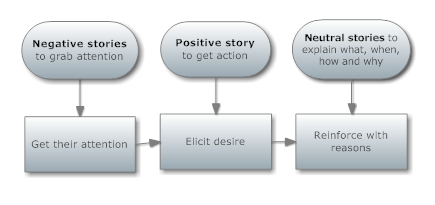 Organize, simplify and get better results from your Web writing by asking 5 important questions:
Organize, simplify and get better results from your Web writing by asking 5 important questions:
- What is the problem (pain, predicament)?
- Why hasn’t this problem been solved?
- What is possible?
- What is different now?
- What should your readers do now?
As you compose your copy, you should write out several sentences to answer each question. This will keep you on task, and lead your readers through to action. I suppose it depends on what you’re writing, but I can’t think of many web pages, blog posts, articles where these 5 questions wouldn’t be appropriate.
I’ve been re-reading Maria Velosa’s Web Copy that Sells this week. Her blueprint for creating simple copy that works to market your products and services is clear. There’s a reason it’s organized this way.
Psychologically, we’re hard wired to sit up and pay attention to problems. This is why it’s a good idea to lead off with your headline and first paragraph addressing readers’ problems and pain. Negative emotions are strong enough to wake us up and get us to read the rest of the story.
There are two things you must realize about this seemingly obvious and simple question:
- People who are in your target audience may not realize they have a problem (or how bad it can get). It may seem surprising, but often people are in denial, are ignoring the bad stuff, and are overly optimistic.
- People need to know you fully understand their pain AND CARE before they will read anything you have to say about it
Write a few sentences out about the problem. You want your readers to say, Read More→












Blog Content: Are you personal… or all business?
I got an interesting comment on a post I did beginning of June and I can’t stop thinking about it. The post was about staying on target with your business goals when you create content for your blog. Don’t Jerk Readers Around: 5 Tips for Staying on Track.
First Eileen said she didn’t agree with my premise that you might be jerking readers around if you’re not staying on track with your content:
“I’m not sure I agree with this. My blog niche is arts and crafts. Most of my favorite other artsy blogs do this routinely. One day they blog about what happening at home. The next they may share a tutorial or run a contest or review a book.”
Then Keenan said, “I agree with Eileen. Although you don’t want to be completely all over the map, changing up your subject matter is critical.
“Blogs represent people. They create connections to their readers through their personalities. When a blog stays on topic all the time, it begins to feel white-washed like any on or off-line newspaper or magazine.
“Personality plays a huge role in a blog. Blogging about those things that are part of the authors passions, likes, dislikes, opinions etc. allows followers to connect with the blog. It’s what makes blogging different than reading commercial news. Read More→